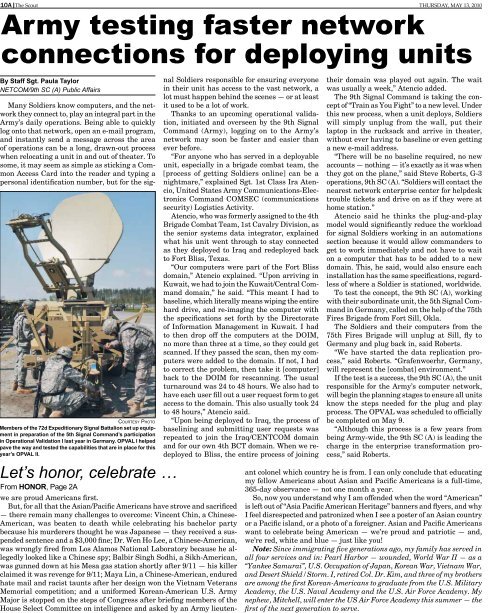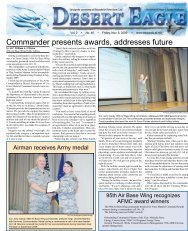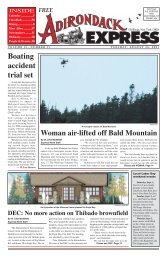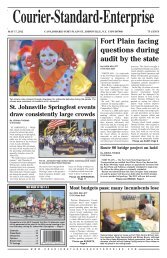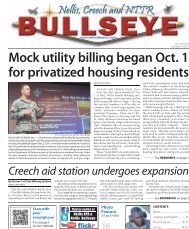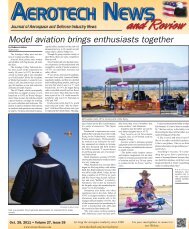the fort huachuca - MediaSpan
the fort huachuca - MediaSpan
the fort huachuca - MediaSpan
You also want an ePaper? Increase the reach of your titles
YUMPU automatically turns print PDFs into web optimized ePapers that Google loves.
10A<br />
The Scout<br />
we are proud Americans first.<br />
But, for all that <strong>the</strong> Asian/Pacific Americans have strove and sacrificed<br />
— <strong>the</strong>re remain many challenges to overcome: Vincent Chin, a Chinese-<br />
American, was beaten to death while celebrating his bachelor party<br />
because his murderers thought he was Japanese — <strong>the</strong>y received a suspended<br />
sentence and a $3,000 fine; Dr. Wen Ho Lee, a Chinese-American,<br />
was wrongly fired from Los Alamos National Laboratory because he allegedly<br />
looked like a Chinese spy; Balbir Singh Sodhi, a Sikh-American,<br />
was gunned down at his Mesa gas station shortly after 9/11 — his killer<br />
claimed it was revenge for 9/11; Maya Lin, a Chinese-American, endured<br />
hate mail and racist taunts after her design won <strong>the</strong> Vietnam Veterans<br />
Memorial competition; and a uniformed Korean-American U.S. Army<br />
Major is stopped on <strong>the</strong> steps of Congress after briefing members of <strong>the</strong><br />
House Select Committee on intelligence and asked by an Army lieuten-<br />
THURSDAY, MAY 13, 2010<br />
Army testing faster network<br />
connections for deploying units<br />
By Staff Sgt. Paula Taylor<br />
NETCOM/9th SC (A) Public Affairs<br />
Many Soldiers know computers, and <strong>the</strong> network<br />
<strong>the</strong>y connect to, play an integral part in <strong>the</strong><br />
Army’s daily operations. Being able to quickly<br />
log onto that network, open an e-mail program,<br />
and instantly send a message across <strong>the</strong> area<br />
of operations can be a long, drawn-out process<br />
when relocating a unit in and out of <strong>the</strong>ater. To<br />
some, it may seem as simple as sticking a Common<br />
Access Card into <strong>the</strong> reader and typing a<br />
personal identification number, but for <strong>the</strong> sig-<br />
CourteSy photo<br />
embers of <strong>the</strong> 72d Expeditionary Signal Battalion set up equipent<br />
in preparation of <strong>the</strong> 5th Signal Command’s participation<br />
n Operational Validation I last year in Germany. OPVAL I helped<br />
ave <strong>the</strong> way and tested <strong>the</strong> capabilities that are in place for this<br />
ear’s OPVAL II.<br />
Let’s honor, celebrate …<br />
From HONOR, Page 2A<br />
nal Soldiers responsible for ensuring everyone<br />
in <strong>the</strong>ir unit has access to <strong>the</strong> vast network, a<br />
lot must happen behind <strong>the</strong> scenes — or at least<br />
it used to be a lot of work.<br />
Thanks to an upcoming operational validation,<br />
initiated and overseen by <strong>the</strong> 9th Signal<br />
Command (Army), logging on to <strong>the</strong> Army’s<br />
network may soon be faster and easier than<br />
ever before.<br />
“For anyone who has served in a deployable<br />
unit, especially in a brigade combat team, <strong>the</strong><br />
[process of getting Soldiers online] can be a<br />
nightmare,” explained Sgt. 1st Class Ira Atencio,<br />
United States Army Communications-Electronics<br />
Command COMSEC (communications<br />
security) Logistics Activity.<br />
Atencio, who was formerly assigned to <strong>the</strong> 4th<br />
Brigade Combat Team, 1st Cavalry Division, as<br />
<strong>the</strong> senior systems data integrator, explained<br />
what his unit went through to stay connected<br />
as <strong>the</strong>y deployed to Iraq and redeployed back<br />
to Fort Bliss, Texas.<br />
“Our computers were part of <strong>the</strong> Fort Bliss<br />
domain,” Atencio explained. “Upon arriving in<br />
Kuwait, we had to join <strong>the</strong> Kuwait/Central Command<br />
domain,” he said. “This meant I had to<br />
baseline, which literally means wiping <strong>the</strong> entire<br />
hard drive, and re-imaging <strong>the</strong> computer with<br />
<strong>the</strong> specifications set <strong>fort</strong>h by <strong>the</strong> Directorate<br />
of Information Management in Kuwait. I had<br />
to <strong>the</strong>n drop off <strong>the</strong> computers at <strong>the</strong> DOIM,<br />
no more than three at a time, so <strong>the</strong>y could get<br />
scanned. If <strong>the</strong>y passed <strong>the</strong> scan, <strong>the</strong>n my computers<br />
were added to <strong>the</strong> domain. If not, I had<br />
to correct <strong>the</strong> problem, <strong>the</strong>n take it [computer]<br />
back to <strong>the</strong> DOIM for rescanning. The usual<br />
turnaround was 24 to 48 hours. We also had to<br />
have each user fill out a user request form to get<br />
access to <strong>the</strong> domain. This also usually took 24<br />
to 48 hours,” Atencio said.<br />
“Upon being deployed to Iraq, <strong>the</strong> process of<br />
baselining and submitting user requests was<br />
repeated to join <strong>the</strong> Iraq/CENTCOM domain<br />
and for our own 4th BCT domain. When we redeployed<br />
to Bliss, <strong>the</strong> entire process of joining<br />
<strong>the</strong>ir domain was played out again. The wait<br />
was usually a week,” Atencio added.<br />
The 9th Signal Command is taking <strong>the</strong> concept<br />
of “Train as You Fight” to a new level. Under<br />
this new process, when a unit deploys, Soldiers<br />
will simply unplug from <strong>the</strong> wall, put <strong>the</strong>ir<br />
laptop in <strong>the</strong> rucksack and arrive in <strong>the</strong>ater,<br />
without ever having to baseline or even getting<br />
a new e-mail address.<br />
“There will be no baseline required, no new<br />
accounts — nothing — it’s exactly as it was when<br />
<strong>the</strong>y got on <strong>the</strong> plane,” said Steve Roberts, G-3<br />
operations, 9th SC (A). “Soldiers will contact <strong>the</strong><br />
nearest network enterprise center for helpdesk<br />
trouble tickets and drive on as if <strong>the</strong>y were at<br />
home station.”<br />
Atencio said he thinks <strong>the</strong> plug-and-play<br />
model would significantly reduce <strong>the</strong> workload<br />
for signal Soldiers working in an automations<br />
section because it would allow commanders to<br />
get to work immediately and not have to wait<br />
on a computer that has to be added to a new<br />
domain. This, he said, would also ensure each<br />
installation has <strong>the</strong> same specifications, regardless<br />
of where a Soldier is stationed, worldwide.<br />
To test <strong>the</strong> concept, <strong>the</strong> 9th SC (A), working<br />
with <strong>the</strong>ir subordinate unit, <strong>the</strong> 5th Signal Command<br />
in Germany, called on <strong>the</strong> help of <strong>the</strong> 75th<br />
Fires Brigade from Fort Sill, Okla.<br />
The Soldiers and <strong>the</strong>ir computers from <strong>the</strong><br />
75th Fires Brigade will unplug at Sill, fly to<br />
Germany and plug back in, said Roberts.<br />
“We have started <strong>the</strong> data replication process,”<br />
said Roberts. “Grafenwoerhr, Germany,<br />
will represent <strong>the</strong> [combat] environment.”<br />
If <strong>the</strong> test is a success, <strong>the</strong> 9th SC (A), <strong>the</strong> unit<br />
responsible for <strong>the</strong> Army’s computer network,<br />
will begin <strong>the</strong> planning stages to ensure all units<br />
know <strong>the</strong> steps needed for <strong>the</strong> plug and play<br />
process. The OPVAL was scheduled to officially<br />
be completed on May 9.<br />
“Although this process is a few years from<br />
being Army-wide, <strong>the</strong> 9th SC (A) is leading <strong>the</strong><br />
charge in <strong>the</strong> enterprise transformation process,”<br />
said Roberts.<br />
ant colonel which country he is from. I can only conclude that educating<br />
my fellow Americans about Asian and Pacific Americans is a full-time,<br />
365-day observance — not one month a year.<br />
So, now you understand why I am offended when <strong>the</strong> word “American”<br />
is left out of “Asia Pacific American Heritage” banners and flyers, and why<br />
I feel disrespected and patronized when I see a poster of an Asian country<br />
or a Pacific island, or a photo of a foreigner. Asian and Pacific Americans<br />
want to celebrate being American — we’re proud and patriotic — and,<br />
we’re red, white and blue — just like you!<br />
Note: Since immigrating five generations ago, my family has served in<br />
all four services and in: Pearl Harbor — wounded, World War II — as a<br />
“Yankee Samurai”, U.S. Occupation of Japan, Korean War, Vietnam War,<br />
and Desert Shield/Storm. I, retired Col. Dr. Kim, and three of my bro<strong>the</strong>rs<br />
are among <strong>the</strong> first Korean-Americans to graduate from <strong>the</strong> U.S. Military<br />
Academy, <strong>the</strong> U.S. Naval Academy and <strong>the</strong> U.S. Air Force Academy. My<br />
nephew, Mitchell, will enter <strong>the</strong> US Air Force Academy this summer — <strong>the</strong><br />
first of <strong>the</strong> next generation to serve.


